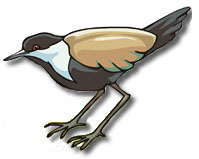You don't need to travel far or have fancy equipment to observe wildlife. From backyard bird feeders to the underside of a rotting log, wildlife is all around you.
Tips for Observing Wildlife  1. Get Up Early 1. Get Up Early
The best times for observing most animals are early in the morning and in the evening. Overcast days are also good times for observing many species!
2. Be Quiet
Make as little noise as possible and listen! You often hear wildlife before you see it. Move slowly and silently!
3. Stay Downwind
If you can, face into the wind when looking for wildlife. Many animals have a keen sense of smell, and the wind can carry your scent and scare them off. Don't wear perfume or any strong smelling scent like shampoo or lotion, animals will pick up your scent!
4. Be Patient
Find a comfortable place to settle in, and be prepared to look, listen, and wait.
 5. Pick a Good Spot 5. Pick a Good Spot
Know what you are looking for and where and when you are most likely to find it.
Always ask permission before going onto private property.
6. Be Prepared
If you have a field guide, bring it with you so you can identify the animals you see. Dress appropriately for the weather! Layers are always good because you can always take something off if you get too warm. Bring a notebook and something to write with so you can record what you see. You might also want to bring a camera and binoculars.
6. Respect Wildlife
Keep your distance from wildlife! Never follow wild animals or try to approach them, and never feed wild animals. If you want a close-up look at wild animals, bring a pair of binoculars with you!
|
|
Signs of Nature   Keep your eyes on an area for more than a few seconds. You may miss an animal if you look away too quickly. Keep your eyes on an area for more than a few seconds. You may miss an animal if you look away too quickly.
 Most animals have some type of coloration that helps them blend into their environment. Look for movement, color contrasts, or shape changes that might signal an animal's presence. Most animals have some type of coloration that helps them blend into their environment. Look for movement, color contrasts, or shape changes that might signal an animal's presence.
 Check for animal tracks or signs like scat (animal droppings); broken, stripped or gnawed branches; and stripped bark. Check for animal tracks or signs like scat (animal droppings); broken, stripped or gnawed branches; and stripped bark.
 Sometimes looking isn't enough, remember to listen for sounds of animals! Rustling leaves, crackling branches, and bird calls can all signal the presence of an animal! Sometimes looking isn't enough, remember to listen for sounds of animals! Rustling leaves, crackling branches, and bird calls can all signal the presence of an animal!
For the Birds  Birds are the easiest animals to observe in the wild! Here are some basic bird watching tips: Birds are the easiest animals to observe in the wild! Here are some basic bird watching tips:
Most bird species are at their most active in the early morning. Learn to identify the birds that are in your own backyard before you venture to other areas! It's a great way to learn more about the birds in your area. If you have a bird feeder or garden, you probably have quite a few bird visitors during the year.
A key to bird watching is often bird listening. Many species of birds can be identified by their distinct song or call. Again, it's easiest to start close to home, so learn the calls and songs of the birds that visit your home first.
A good bird identification field guide is important if you want to identify the birds you see! eNature has a nice online guide. |

 1. Get Up Early
1. Get Up Early 5. Pick a Good Spot
5. Pick a Good Spot
 Birds are the easiest animals to observe in the wild! Here are some basic bird watching tips:
Birds are the easiest animals to observe in the wild! Here are some basic bird watching tips: